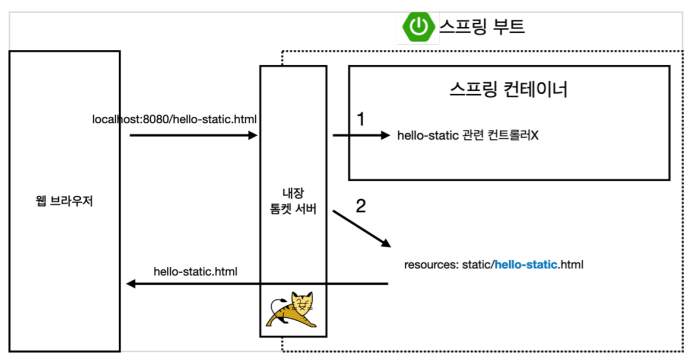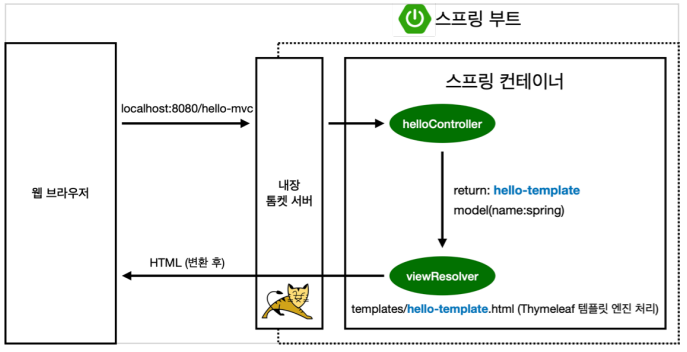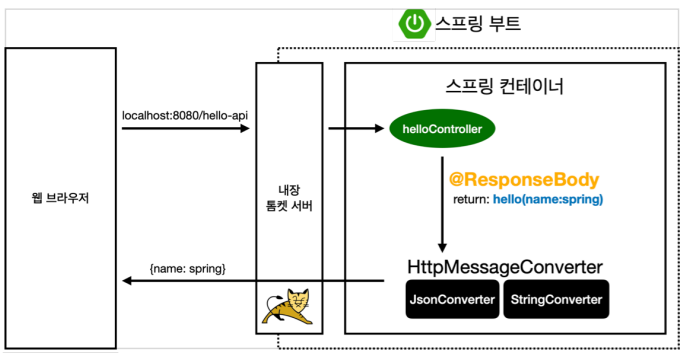1. 정적 컨텐츠
resources/static/hello-static.html
<!DOCTYPE HTML>
<html>
<head>
<title>Hello</title>
<meta http-equiv="Content-Type" content="text/html; charset=UTF-8" />
</head>
<body>
Hello
<a href="/hello">hello</a>
</body>
</html>
[ 작동원리 ]

- hello-static 관련 컨트롤러가 없으므로 바로 hello-static.html을 찾아 그대로 출력해줌
2. MVC와 템플릿 엔진
- view는 화면을 그리는데 모든걸 쏟음
- controller, model -> 내부적인거 통제(비즈니스 로직, 서버 등)
- 템플릿 엔진: 랜더링이 된 html을 고객에게 전달
2-1. controller에서 지정한 단어 넘기기
- model.addAttribute로 "hello!!"를 지정함
[ Controller ]
package hello.hellospring.controller;
import org.springframework.stereotype.Controller;
import org.springframework.ui.Model;
import org.springframework.web.bind.annotation.GetMapping;
@Controller
public class HelloController {
@GetMapping("hello")
public String hello(Model model) {
model.addAttribute("data", "hello!!");
return "hello";
}
}[ View ]
<!DOCTYPE HTML>
<html xmlns:th="http://www.thymeleaf.org">
<head>
<title>Hello</title>
<meta http-equiv="Content-Type" content="text/html; charset=UTF-8" />
</head>
<body>
<p th:text="'안녕하세요. ' + ${data}" >안녕하세요. 손님</p>
</body>
</html>
- parameter로 값을 받아오지못하면 white label이 뜸
2-2. 외부에서 단어 입력해 넘기기
- 파라미터(name)을 받아와서 hello-template.html에 model.addAttribute를 이용해 name을 넘겨줌
[ Controller ]
@GetMapping("hello-mvc")
public String helloMvc(@RequestParam(value="name", required = true) String name, Model model) {
model.addAttribute("name", name);
return "hello-template";
}- required=true가 default이므로 안적어도 괜찮음
[ View ]
<html xmlns:th="http://www.thymeleaf.org">
<body>
<p th:text="'hello ' + ${name}">hello! empty</p>
</body>
</html>- thymeleaf의 장점
- 서버없이 absolute path를 이용해 크롬에서 열어도 (hello! empty)로 나옴
- 동작을 하면 th:text의 내용으로 나옴

[ 작동 원리 ]
3. API
3-1. @ResponseBody 문자 반환
- html파일 없이 http의 body부에 직접 데이터 넣기
- json이라는 데이터 포멧으로 클라이언트한테 데이터 전달(다양한 방법이 있지만, 최근에는 json으로 많이 함)
[ Controller ]
@GetMapping("hello-string")
@ResponseBody
public String helloString(@RequestParam("name") String name) {
return "hello " + name;
}- @ResponseBody : html의 가 아나리 http(header/body)에서의 body부에 내가 직접 데이터 넣겠다는 의미

- @ResponseBody 를 사용하면 뷰 리졸버(viewResolver) 사용하지 않음(.html)
3-2. @ResponseBody 객체 반환
- @ResponseBody 를 사용해 객체를 반환하며, 이때 객체는 json으로 변환됨
[ Controller ]
@GetMapping("hello-api")
@ResponseBody
public Hello HelloAPI(@RequestParam("name") String name) {
Hello hello = new Hello();
hello.setName(name);
return hello;
}
static class Hello {
private String name;
public String getName() {
return name;
}
public void setName(String name) {
this.name = name;
}
}[ 작동 원리 ]
- HTTP의 BODY에 문자 내용을 직접 반환
- viewResolver(MVC패턴의 view) 대신에 HttpMessageConverter 가 동작
- 기본 문자처리: StringHttpMessageConverter
- 기본 객체처리: MappingJackson2HttpMessageConverter
- byte 처리 등등 기타 여러 HttpMessageConverter가 기본으로 등록되어 있음

